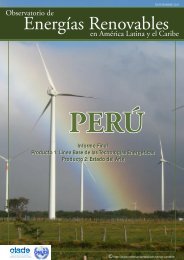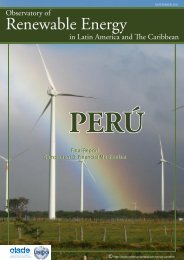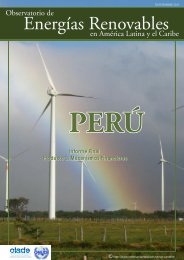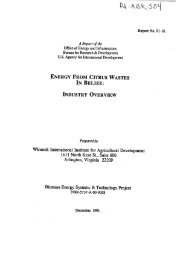PERÃ - Observatory for Renewable Energy in Latin America and
PERÃ - Observatory for Renewable Energy in Latin America and
PERÃ - Observatory for Renewable Energy in Latin America and
You also want an ePaper? Increase the reach of your titles
YUMPU automatically turns print PDFs into web optimized ePapers that Google loves.
<br />
Perú- Products I <strong>and</strong> II<br />
<br />
2. STATE OF ART<br />
2.1 Introduction<br />
In Peru, the use of the renewable energy sources started on the 70's, be<strong>in</strong>g<br />
encouraged <strong>for</strong> the oil crisis. At first, the development of projects was <strong>in</strong> charge<br />
of <strong>in</strong>stitutions of tra<strong>in</strong><strong>in</strong>g <strong>and</strong> technological development, like universities. The<br />
first developed applications correspond to water pump<strong>in</strong>g w<strong>in</strong>dmills, solar water<br />
heaters <strong>and</strong> solar driers of agricultural products.<br />
In 1993 the electrification coefficient <strong>in</strong> Peru was the lowest <strong>in</strong> South <strong>America</strong>:<br />
56,8 % at a national scale <strong>and</strong> 7,7 % <strong>in</strong> rural areas, be<strong>in</strong>g nowadays 86 % at a<br />
national scale <strong>and</strong> 65 % <strong>in</strong> rural areas. (MEM, 2011j). The acces to electric power<br />
of the communities located <strong>in</strong> rural areas is very complicated due to the varied<br />
geography <strong>and</strong> the low population density.<br />
The M<strong>in</strong>istry of <strong>Energy</strong> <strong>and</strong> M<strong>in</strong>es of Peru, due to the necessity of electrification<br />
coverage, unroll different programs to provide rural population of electric power.<br />
For its achievement, it executes the implementation of isolated generation<br />
systems, pr<strong>in</strong>cipally with small Hydroelectric Power Stations <strong>and</strong> Solar<br />
Photovoltaic Plants, as the country has little waterfalls <strong>and</strong> elevated levels of solar<br />
radiation that makes these systems the cheapest. Electrification projects<br />
developed by the government through the M<strong>in</strong>istry of <strong>Energy</strong> <strong>and</strong> M<strong>in</strong>es ma<strong>in</strong>ly<br />
reflect a social commitment <strong>and</strong> the <strong>in</strong>dividual capacity of these projects has not<br />
yet exceeded a megawatt.<br />
At present, it can be seen that the most important projects developed with<br />
renewable sources are <strong>in</strong> private h<strong>and</strong>s, encouraged, as it was detailed <strong>in</strong> chapter<br />
1, by the legal framework that regulates <strong>and</strong> promotes <strong>in</strong>vestment <strong>in</strong> that k<strong>in</strong>d of<br />
projects. In this section there will be described 2 projects, which have been<br />
selected based on the degree of “success” achieved <strong>in</strong> the <strong>in</strong>side market, be<strong>in</strong>g<br />
their ma<strong>in</strong> characteristic the susta<strong>in</strong>ability.<br />
The first project analyzed <strong>in</strong> this study is the Hydroelectric Power Station “Santa<br />
Cruz II”, which uses water from the “Rio Blanco” river to generate electricity.<br />
The second project turns out to be the Cogeneration Station “Paramonga I”. This<br />
station uses residual biomass as fuel, result<strong>in</strong>g from the the use of sugar cane, <strong>in</strong><br />
order to generate thermal <strong>and</strong> electric energy <strong>for</strong> the processes of its area of<br />
<strong>in</strong>fluence <strong>and</strong> to <strong>in</strong>ject <strong>in</strong> the SEIN the electricity surplus.<br />
Just like other renewable sources, the projects <strong>in</strong> mention contribute to the<br />
susta<strong>in</strong>able development of the <strong>in</strong>volved populations <strong>and</strong> help the country to<br />
improve the trade balance of hydrocarbons, displac<strong>in</strong>g the electric power<br />
generation of thermic plants that use fossil fuels <strong>and</strong> contribut<strong>in</strong>g to the reduction<br />
of the import<strong>in</strong>g of oil <strong>for</strong> electricity generation.<br />
110









